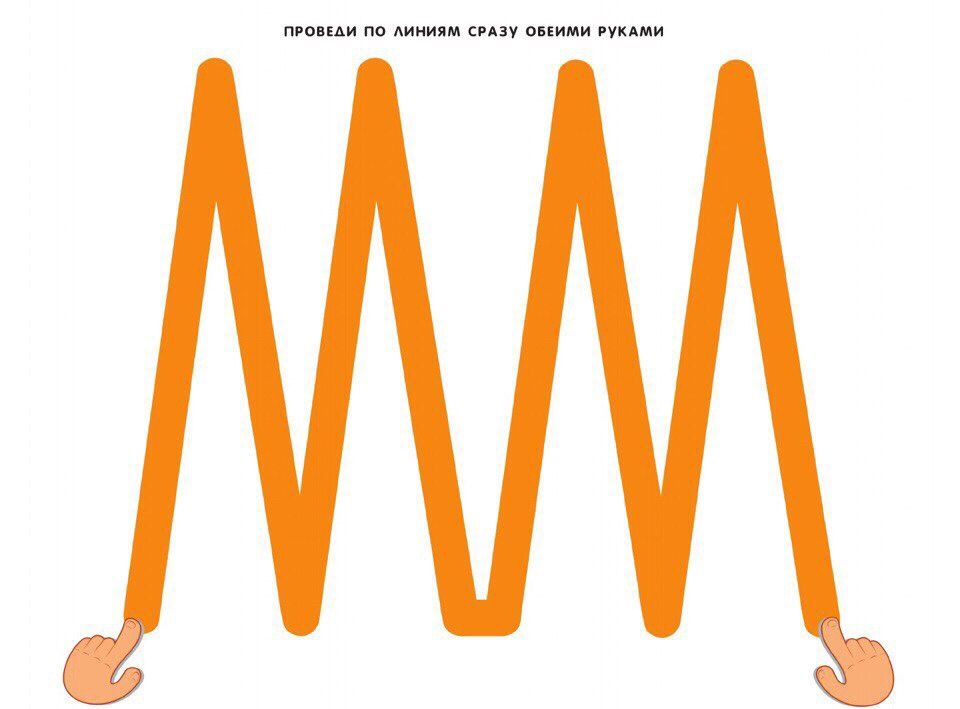
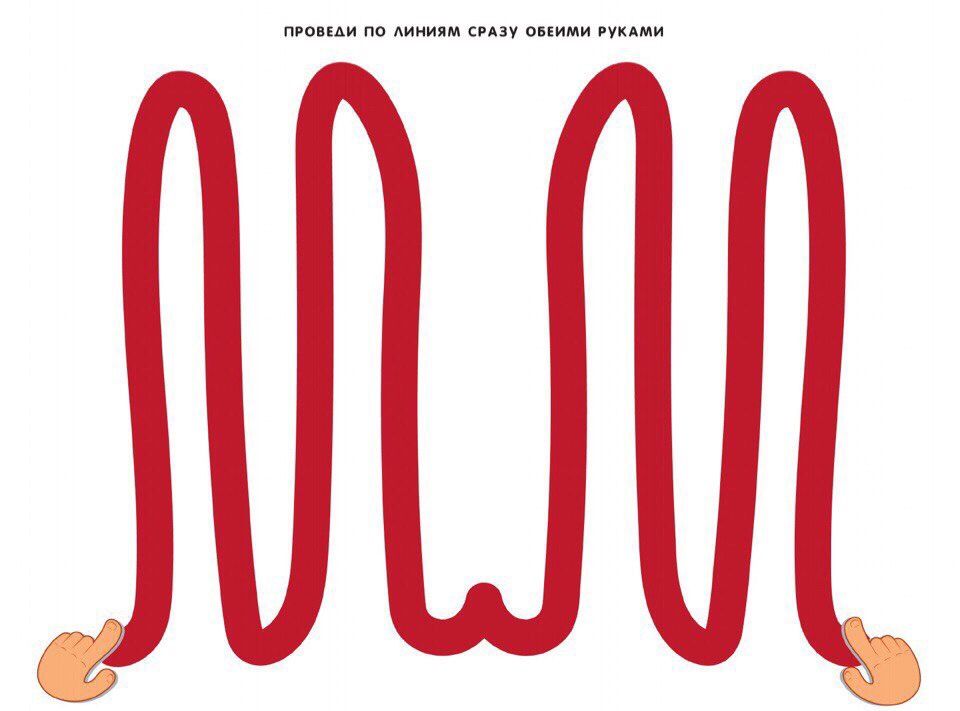
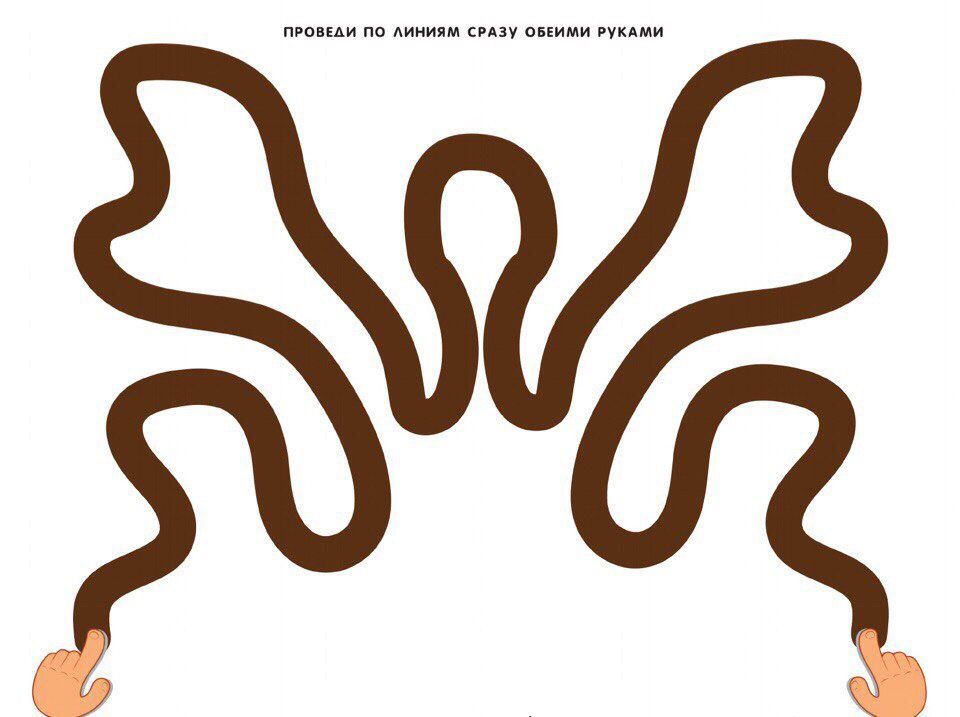
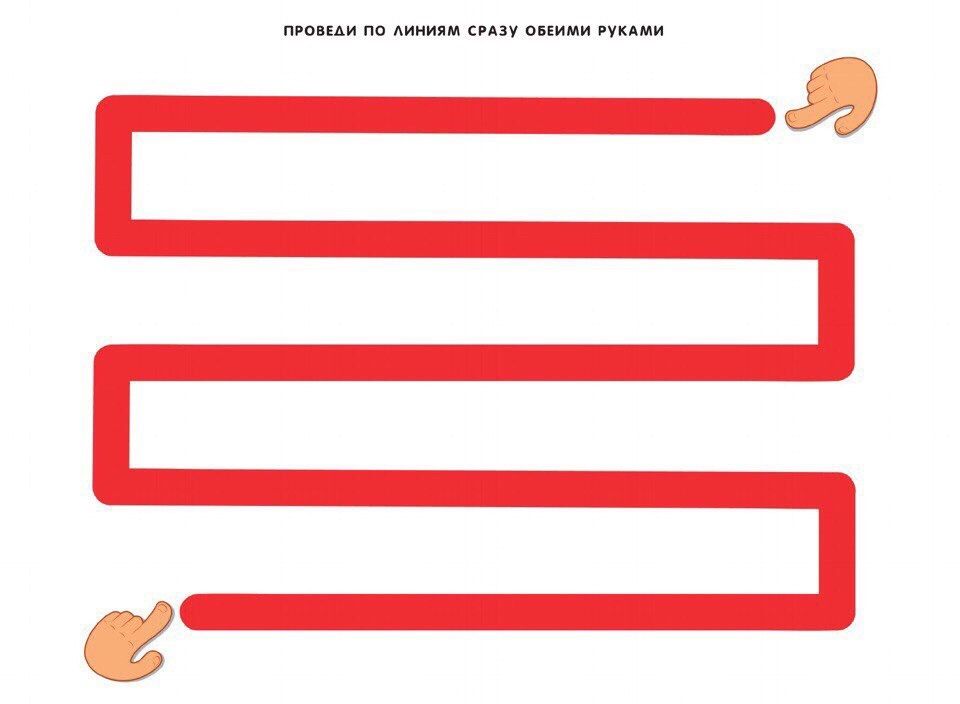
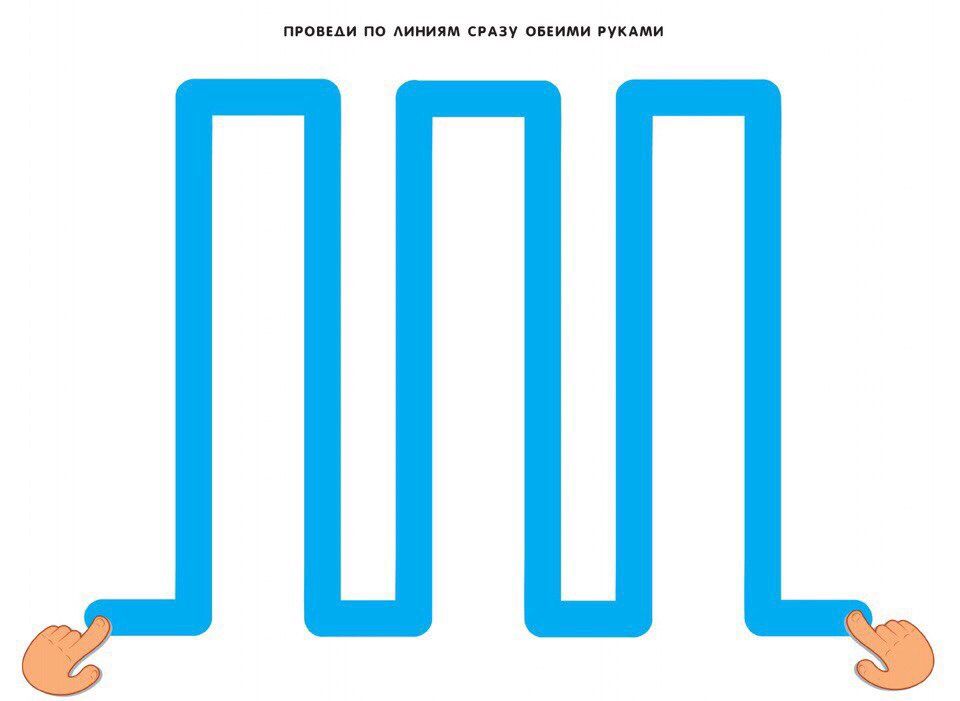
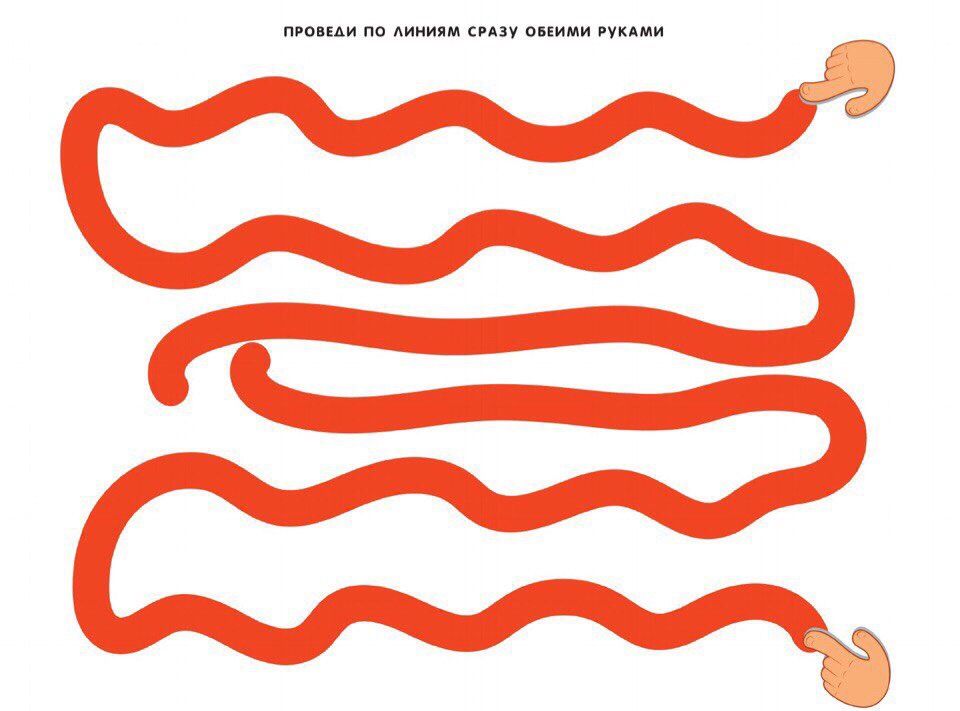
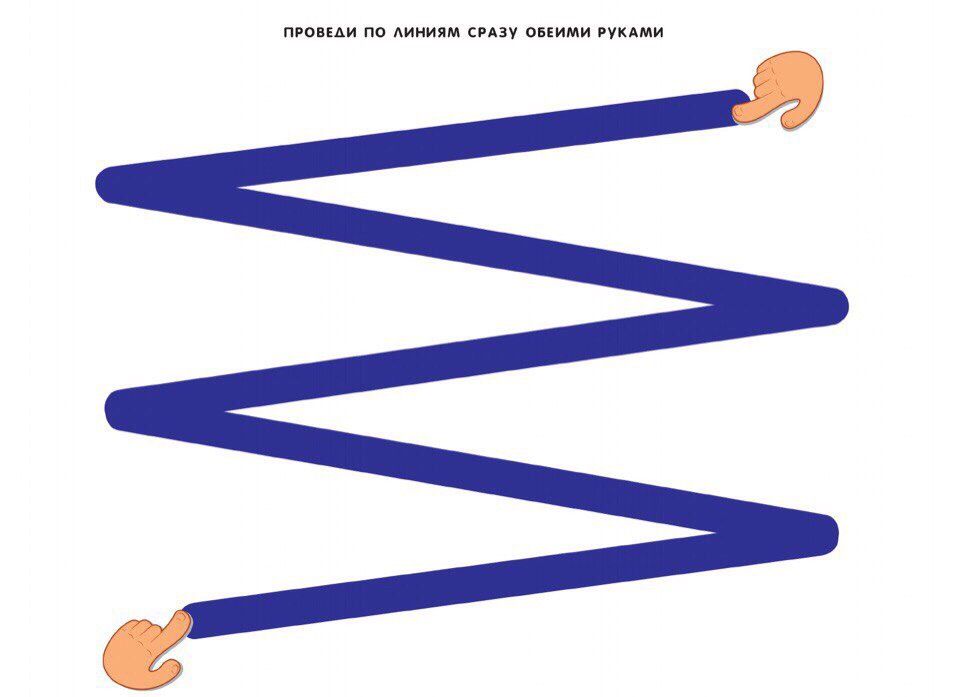
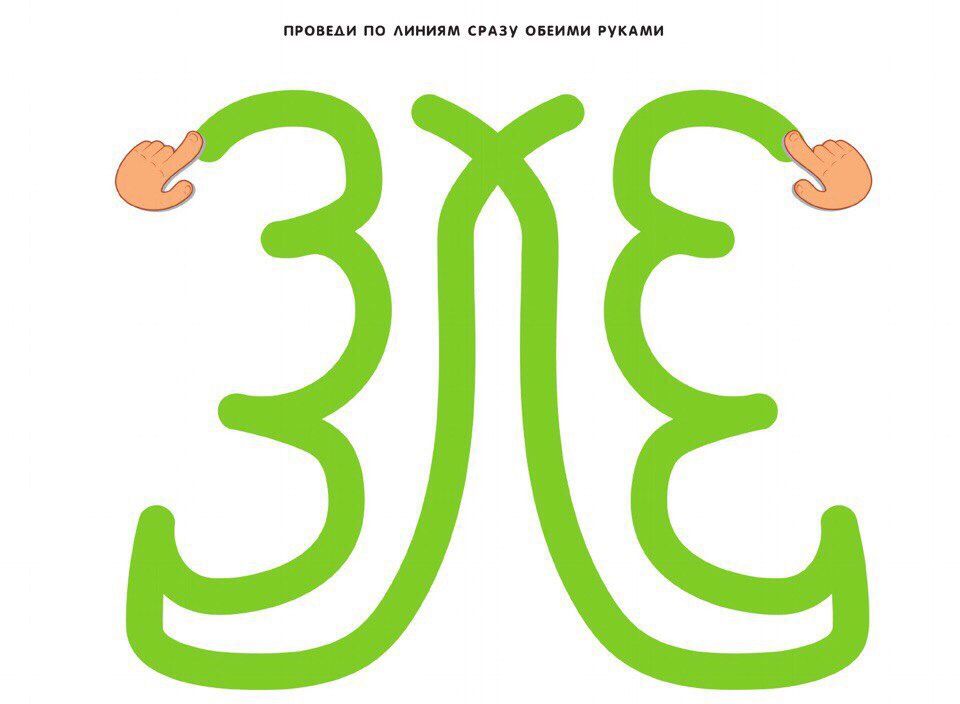
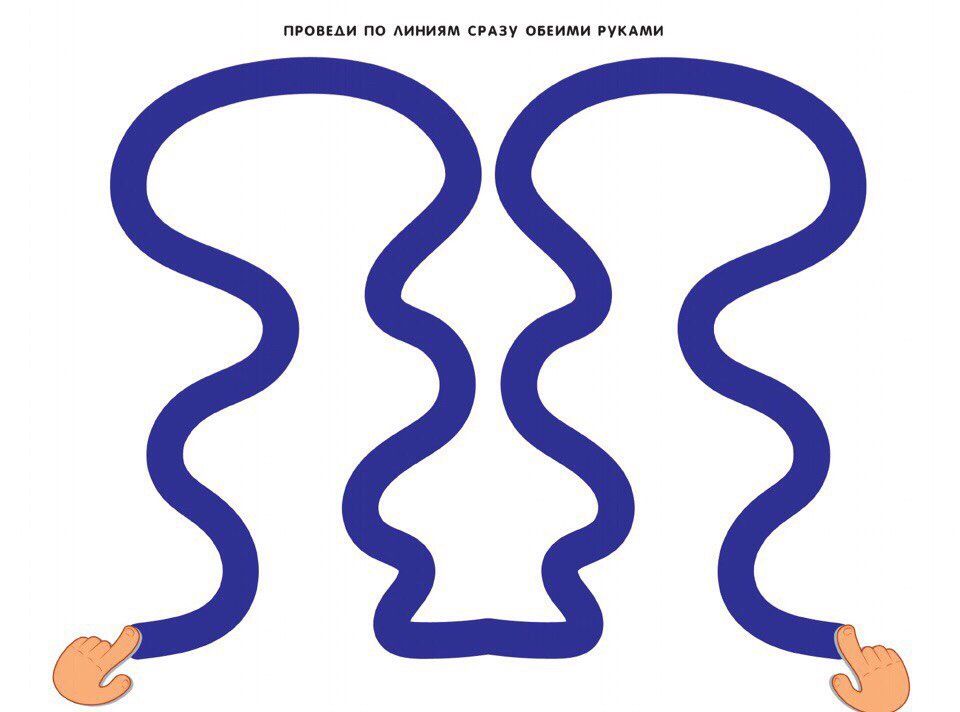
Printable material here:
hands.pdf
Tracks for the right and left hand, a game for the development of the right and left hemisphere
It is necessary to draw simultaneously with the right and left hand along the tracks.
Exercises and games for the development of interhemispheric interaction:
1. Tap on the table with a relaxed right hand and then left hand.
2. Turn your right hand on the rib, bend your fingers into a fist, straighten, put your hand in your palm. Do the same with your left hand.
3. Call. Leaning on the table with your palms, bend your elbows in your hands. Shake brushes in turn.
4. House. Connect the end phalanges of the extended fingers with the fingers of your right hand, press the fingers of your left hand with force, then vice versa. Practice these movements for each pair of fingers separately.
5. Tap on the table with each finger of your right hand under the score “1.1-2.1-2-3 etc.”.
6. Lock the forearm of the right hand on the table. With the index and middle fingers, take a pencil from the table, raise and lower it. Do the same with your left hand.
7. Roll out on the board a small ball of play-doh with the fingers of the right hand, then the left.
8. Rotate the pencil first between the fingers of the right hand, then the left (between the thumb and index, middle, ring and pinky finger; then in the opposite direction).
9. Lock the forearm on the table. Take the matches from the box on the table with your fingers of your right hand and put them side by side without moving your forearm. Then put them back in the box. Do the same with your left hand.
10. While sitting, bend your elbows, squeeze and open your hands, gradually speeding up the pace. Perform these to the maximum speed. Then relax your hands and shake.
11. Stretch your arms in front of you, bend your hands up and down. Then rotate with both hands clockwise and counterclockwise (first unidirectionally, then multidirectionally), bring and spread the fingers of both hands. Try to open and close your mouth with hand movements at the same time..
12. Follow your eyes on the contour of an imaginary figure (circle, triangle, square) or numbers.
13. Exercise in pairs: stand opposite each other, touch the palms to the palms of the partner. Move them like bike pedals.
14. With your right hand, massage your left hand from the elbow to the wrist and vice versa. Then from the shoulder to the elbow and back. Do the same movement with the other hand.
15. Press your palm against the table surface. First, in order, and then randomly raise your fingers one at a time and name them.
16. Treasure. A toy or candy is hiding in the room. Find it, focusing on the leader’s commands, for example: “Take two steps forward, one to the right, etc.”.
17. Joint movements of the eyes and tongue. With your tongue and eyes out of your mouth, make joint movements from side to side, rotating them in a circle, along the path of the lying figure eight. First, unidirectional movements are worked out, then - multidirectional movements.
18. Clap your palm several times so that the fingers of both hands touch. Then slam with fists oriented with the back surface first up and then down.
19. Close your eyes. Try to identify a small item that will be given to your hand. With your other hand, draw it on paper (write it in the air).
20. Pair exercises: stand facing each other. One of the partners performs movements with arms or legs, the other should mirror them.
21. Mirror painting. Put a blank sheet of paper on the table. Take a pencil or marker pen in both hands. Start drawing at the same time with both hands mirror-symmetric drawings, letters. When doing this exercise, feel your eyes and hands relax. When the activity of both hemispheres is synchronized, the efficiency of the whole brain will noticeably increase.
22. Hold the pencil with the middle and index fingers. Bend and unbend these fingers so that the pencil does not fall below the thumb. The exercise is performed first with one hand, then with the other hand.
23. Put 10-15 pencils on the table. It is necessary to collect all the pencils with one hand in a fist, taking them one at a time. Then put them on the table one at a time.
24. Horizontal figure eight. Extend the right hand in front of you at eye level, fingers clench into a fist, leave the index and middle extended. Draw in the air with these fingers the sign of infinity as large as possible. When the hand from the center of this sign goes up, start tracking with unblinking eyes fixed on the gap between the ends of these fingers without turning your head. Those who have difficulties in tracking (tension, frequent blinking) should remember the segment of the “horizontal eight”, where this happens, and draw your hand several times, as if smoothing this area. It is necessary to achieve a smooth eye movement without stops and fixations. In the place where the tracking loss is stopped, you need to draw your hand back and forth several times along the horizontal eight line. Simultaneously with your eyes, follow the movements of the fingers along the horizontal eight path with your tongue well out of your mouth.
25. A little ring. Alternately and as quickly as possible to sort out the fingers, connecting in a ring with the thumb smoothly and alternately, sequentially index, middle, etc. The test is performed in the direct (from index to little finger) and in reverse (from little finger to index) order. First, the technique is performed by each hand separately, then together.
26. Lezginka (Georgian Song). The left hand is folded into a fist, the thumb is set aside, the fist is turned with the fingers towards you. The right hand with a straight palm in horizontal position touches the little finger of the left. After that, the change of right and left hands simultaneously changes during 6-8 position changes. Achieve high speed position changes.
27. Ear - nose. With your left hand, grab the tip of your nose, and with your right hand, hold the opposite ear. At the same time release your ear and nose, clap your hands, change the position of your hands "exactly the opposite".
28. Pose of Napoleon. Wrap yourself in arms, changing the right, then left hands in the upper and lower positions.
With the influence of kinesiology training, positive structural changes occur in the body. Moreover, the more intense the load (but optimal for these conditions), the greater the change. Strength, balance, mobility, plasticity of nervous system processes is carried out at a higher level. The regulatory and coordinating role of the nervous system is being improved. These techniques can reveal the hidden abilities of a person and expand the boundaries of the possibilities of activity of his brain. It should be noted that these methods do not require material costs, are convenient to use, organically fit into the structure of classes, and most importantly, students fulfill them with great desire and pleasure, which is important for the growth of motivation in learning.

